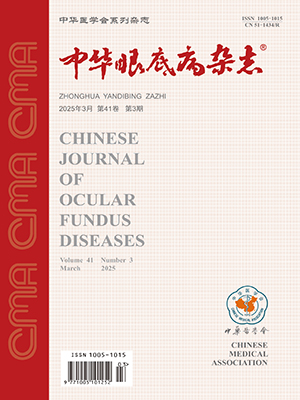ObjectiveTo evaluate the efficacy and security of intravitreous injection with triamcinolone acetonide (TA) for macular edema.MethodsA total of 41 eyes in 37 patients with macular edema who measured up were collected, including 21 eyes of 21 cases in retinal vein occlusion (RVO) group, 17 eyes of 13 cases in diabetic retinopathy (DR) group, and 3 eyes of 3 cases in the other-causes group. Before the treatment, the average visual acuity was 0.07, 0.06, and 0.08 in the 3 groups respectively, and the mean thickness of macular fovea detected by optic coherence tomography (OCT) was (974±394) and (873±213) in RVO and DR group, respectively. Intravitreous injection with 0.1 ml TA (40 mg/ml) was performed on each patient. The average follow-up duration was 8 months after the treatment. The visual acuity, intraocular pressure (IOP), changes of lens and ocular fundus, and retinal thichness at macular area before and after the treatment was observed and compared.ResultsAll eyes except one had improved visual acuity. The mean visual acuity improved to 0.25, 0.20, and 0.35 in the 3 groups respectively 6 months after the treatment. Alleviated or reducing macular edema was found in all of the patients. The average retinal thickness at macular fovea was (173±41) and (204±76) in RVO and DR group respectively 1 month after the treatment, which had statistical significance compared with that before the treatment (t =8.323, 6.842; P<0.01). The intraocular pressure was >21 mm Hg (1 mm Hg = 0.133 kPa) in 6 eyes (14.6%), which mostly happened 1 week to 2 months after the injection, and was controlled to normal level after partially treated with βreceptor retarder. The cataract developed in 1 eye, and another patient with macular edema after vitrectomy due to diabetes had macular hole 2 months after the injection. There were 2 eyes underwent intravitreous injection with 0.1 ml TA 4-5 months after the first treatment due to the recurrence of macular edema in RVO and DR group respectively.ConclusionsIntravitreous injection with TA is a promising therapeutic method for macular edema that fails to respond to conventional treatment. Transient elevation of ocular pressure is the most common side effect. Further study is needed to assess the long-term efficacy and safety. (Chin J Ocul Fundus Dis, 2005,21:209-212)
Citation: CHANG Qing,WANG Wenji. Intravitreous injection with triamcinolone acetonide for macular edema. Chinese Journal of Ocular Fundus Diseases, 2005, 21(4): 209-212. doi: Copy
Copyright © the editorial department of Chinese Journal of Ocular Fundus Diseases of West China Medical Publisher. All rights reserved




